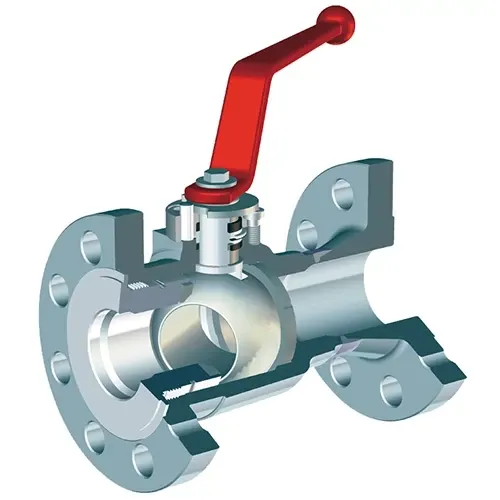Floating ball valves are typically made from materials like stainless steel, brass, or plastic, making them suitable for a wide range of media, including water, oil, gas, and corrosive substances. They are available in various sizes and pressure ratings, catering to diverse applications across industries such as oil and gas, water treatment, and chemical processing.
 Floating ball valves operate through a simple yet effective mechanism involving a rotating ball and a stem. Here’s a breakdown of their working principle:
The valve is operated by a shaft or stem attached to the top of the ball. This stem allows the user to turn the ball 90 degrees (a quarter turn) to open or close the valve.
As the ball rotates, it either covers or uncovers the port in the valve body, controlling the flow of media. When the valve is open, the flow path is clear; when closed, the ball seals against the downstream seat to prevent any leakage.
The unique feature of a floating ball valve is that the ball is not fixed in position. Instead, it is loosely attached to the stem, allowing it to move slightly. When there is flow through the valve, the pressure of the media forces the ball against its downstream seat, creating a tight seal. This mechanism ensures that the valve effectively prevents backflow and leaks when in the closed position.
One important aspect of floating ball valves is their sealing ability, which is influenced by the pressure of the media. In typical applications, the downstream pressure is sufficient to keep the ball pressed against the seat, maintaining a tight seal. However, in low-pressure applications, the effectiveness of the seal may diminish over time due to wear on the seats. If the media pressure is not adequate, there may not be enough force to hold the ball against the downstream seat, leading to potential leakage.
Floating ball valves are widely used in various industries, including oil and gas, water treatment, HVAC systems, and food and beverage processing. Their ability to handle high flow rates and pressures makes them suitable for critical applications, while their simple design ensures ease of operation and maintenance.
The advantages of floating ball valves include:
Fewer moving parts mean less chance of mechanical failure.
When properly maintained, they provide excellent sealing capabilities.
The quarter-turn operation allows for rapid opening and closing of the valve.
Suitable for a wide range of media and environments.
Despite their advantages, floating ball valves have some limitations, including:
Floating ball valves operate through a simple yet effective mechanism involving a rotating ball and a stem. Here’s a breakdown of their working principle:
The valve is operated by a shaft or stem attached to the top of the ball. This stem allows the user to turn the ball 90 degrees (a quarter turn) to open or close the valve.
As the ball rotates, it either covers or uncovers the port in the valve body, controlling the flow of media. When the valve is open, the flow path is clear; when closed, the ball seals against the downstream seat to prevent any leakage.
The unique feature of a floating ball valve is that the ball is not fixed in position. Instead, it is loosely attached to the stem, allowing it to move slightly. When there is flow through the valve, the pressure of the media forces the ball against its downstream seat, creating a tight seal. This mechanism ensures that the valve effectively prevents backflow and leaks when in the closed position.
One important aspect of floating ball valves is their sealing ability, which is influenced by the pressure of the media. In typical applications, the downstream pressure is sufficient to keep the ball pressed against the seat, maintaining a tight seal. However, in low-pressure applications, the effectiveness of the seal may diminish over time due to wear on the seats. If the media pressure is not adequate, there may not be enough force to hold the ball against the downstream seat, leading to potential leakage.
Floating ball valves are widely used in various industries, including oil and gas, water treatment, HVAC systems, and food and beverage processing. Their ability to handle high flow rates and pressures makes them suitable for critical applications, while their simple design ensures ease of operation and maintenance.
The advantages of floating ball valves include:
Fewer moving parts mean less chance of mechanical failure.
When properly maintained, they provide excellent sealing capabilities.
The quarter-turn operation allows for rapid opening and closing of the valve.
Suitable for a wide range of media and environments.
Despite their advantages, floating ball valves have some limitations, including:Pressure Dependency: Their sealing capability may decline in low-pressure applications.
Wear Over Time: As the seats wear down, the effectiveness of the seal may diminish, especially if not regularly maintained. Floating ball valves are essential components in fluid control systems, offering efficient operation and reliable sealing in a variety of applications. Their simple design, combined with effective sealing capabilities, makes them a popular choice across numerous industries. Understanding how floating ball valves work, along with their advantages and potential limitations, is crucial for making informed decisions when selecting valves for specific applications. By considering the operating conditions and maintenance needs, users can ensure optimal performance and longevity of these versatile valves.